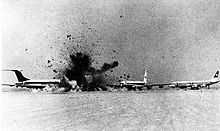| Dawson's Field hijackings | |
|---|---|
| Part of Black September in Jordan and spillover of Palestinian insurgency in South Lebanon | |
 Three airliners were destroyed by explosion at Dawson's Field on 12 September 1970. | |
| Location | Dawson's Field, Zarqa, Jordan |
| Coordinates | 32°06′21″N 36°09′24″E / 32.1059°N 36.1567°E |
| Date | 6–13 September 1970 |
| Target | TWA 741, Swissair 100, El Al 219, Pan Am 93, BOAC 775 |
Attack type | 4 successful aircraft hijackings, 1 foiled, hostage crisis |
| Weapons | Firearms and hand grenades |
| Deaths | 1 (1 hijacker) |
| Injured | 1< |
| Perpetrators | Popular Front for the Liberation of Palestine |
| Defenders | Bar Lev, passengers and sky marshal (Flight 219) |
| Motive | Release of Palestinian prisoners imprisoned in Europe and Israel |
In September 1970, members of the Popular Front for the Liberation of Palestine (PFLP) hijacked four airliners bound for New York City and one for London. Three aircraft were forced to land at Dawson's Field, a remote desert airstrip near Zarqa, Jordan, formerly Royal Air Force Station Zarqa, which then became PFLP's "Revolutionary Airport". By the end of the incident, one hijacker had been killed and one injury reported. This was the second instance of mass aircraft hijacking, after an escape from communist Czechoslovakia in 1950.
On 6 September, TWA Flight 741 from Frankfurt (a Boeing 707) and Swissair Flight 100 from Zürich (a Douglas DC-8) were forced to land at Dawson's Field.[1][2] On the same day, the hijacking of El Al Flight 219 from Amsterdam (another 707) was foiled: hijacker Patrick Argüello was shot and killed, and his partner Leila Khaled was subdued and handed over to British authorities in London. Two PFLP hijackers, who were prevented from boarding the El Al flight, hijacked instead Pan Am Flight 93, a Boeing 747, diverting the large aircraft first to Beirut and then to Cairo, rather than to the small Jordanian airstrip. On 9 September, a fifth aircraft, BOAC Flight 775, a Vickers VC10 coming from Bahrain, was hijacked by a PFLP sympathizer and taken to Dawson's Field in order to pressure the British to free Khaled.
While the majority of the 310 hostages were transferred to Amman and freed on 11 September, the PFLP segregated the flight crews and Jewish passengers, keeping the 56 Jewish hostages in custody, while releasing the non-Jews. Six hostages in particular were kept because they were men and American citizens, not necessarily Jews: Robert Norman Schwartz, a U.S. Defense Department researcher stationed in Thailand; James Lee Woods, Schwartz's assistant and security detail; Gerald Berkowitz, an American-born Jew and college chemistry professor; Rabbi Avraham Harari-Raful and his brother Rabbi Yosef Harari-Raful, two Sephardi Brooklyn school teachers; and John Hollingsworth, a U.S. State Department employee. Schwartz, whose father was Jewish, was a convert to Catholicism.[3][4][5] On 12 September, prior to their announced deadline, the PFLP used explosives to destroy the empty planes, as they anticipated a counterstrike.[1]
The PFLP's exploitation of Jordanian territory was an example of the increasingly autonomous Arab Palestinian activity within the Kingdom of Jordan – a serious challenge to the Hashemite monarchy of King Hussein. Hussein declared martial law on 16 September and from 17 to 27 September his forces deployed into Palestinian-controlled areas in what became known as Black September in Jordan, nearly triggering a regional war involving Syria, Iraq, and Israel.
A swift Jordanian victory, however, enabled a 30 September deal in which the remaining PFLP hostages were released in exchange for Khaled and three PFLP members in a Swiss prison.[1]
- ^ a b c BBC News, "On This Day: 12 September". "Hijacked jets destroyed by guerrillas". BBC News. 12 September 1970. Retrieved 1 May 2006.
- ^ Dawson's Field was named after Air Chief Marshal Sir Walter Dawson Air of Authority – A History of RAF Organisation – Air Chief Marshal Sir Walter Dawson Archived 21 August 2017 at the Wayback Machine refers
- ^ "Britain Releases Girl Guerilla". The Palm Beach Post. 1 October 1970. Retrieved 16 December 2014.[permanent dead link]
- ^ "Robert Schwartz; Defense Official Was Hostage in Hijacking". The Washington Post. 17 June 2007. Retrieved 16 December 2014.
- ^ Cite error: The named reference
Tugendwas invoked but never defined (see the help page).